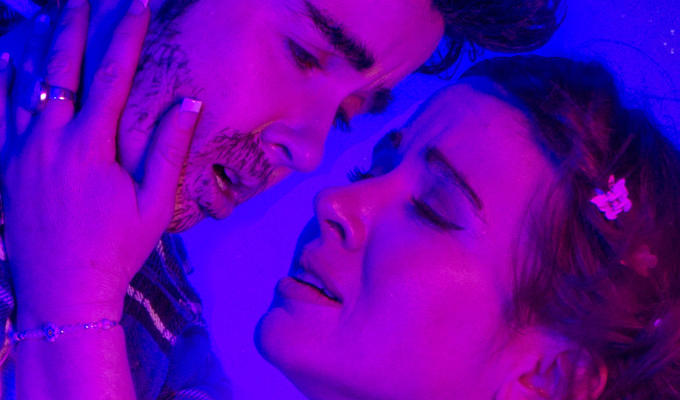
London Clown Festival Opening Gala
Note: This review is from 2018
Gig review by Steve Bennett
Clowning is a very broad church, given that it just means to be light, playful and silly. But its disciplines of physical humour, of loosening the ego, and of coaxing an audience on to a journey they are an intrinsic part of, have become increasingly prevalent on the festival comedy circuit.
London even has its own clown festival, now in its third year. And of course there’s not a red nose, oversized shoe or unroadworthy car to be seen…
Its showcase launch was hosted by The Establishment – Neil Frost and festival co-founder Dan Lees. These duo of daft cultured gents are close relatives Monty Python’s toffs with their brollies, their bowlers and their copies of the Financial Times stuffed into the pockets of their three-piece suits. However, this tailoring is less Saville Row pinstripe, more repurposed 1950s tablecloths.
They evoke end-of-the pier variety shows with their jaunty poses, bobbing up and down and repeating silly pseudo-catchphrases in a sing-song voice. Their banter is tightly synchronised, and sometimes they even try to improvise a sentence together, an endeavour which always ends up weird, sometimes unusably so.
Such unstructured ad libbing – far from the rigid rules and regulations of improv games – come to define the night, across most of the acts. Sometimes that spirit produces a lovely moment of spontaneous silliness, sometimes it smacks of self-indulgence as performers grasp for an elusive laugh.
That said, in his red leggings and artist’s smock, wild hair and expressive face, opening act Inda Pereda is a fairly conventional example of modern European clowning. If ‘conventional’ and ‘clowning’ can cohabit the same sentence, that is.
His set here involves miming the eating of various juicy fruits, which becomes orgasmic, before he dips into the crowd, playing slightly with their discomfort, to envisage a society of sentient nits on one punter’s head, whose aggressive actions he acts out in a flurry of sound effects.
Pereda is technically strong with a nice way of contriving nonsense, but has a rather too familiar a persona of the over-eager child-like weirdo, acting out imaginary scenarios in his own little world.
Marny Godden has a lot more going on, taking to the stage as if a town crier proclaiming the festival open. Though when the clanger falls out of her bell, she recruits audience members (including fellow performer Michael Brünstom who happened to be sitting in the front row) to provide the noises.
As well as this persona, she also maintains her convincing alter-ego of One Tooth, the pudgy punk-haired and dentally deficient geezer who often features in her work. She makes subtly clear she’s aware of the absurdity of it all, and the oddness gets plenty of laughs, even if she has a tendency to milk some of them too much.
Next up, Norway’s Viggo Venn, sometimes of the Zach and Viggo double act, but this time accompanied by S Club 7. The popsters provide not only his walk-on music but an ‘unwanted’ accompaniment to his whole shambolic set, as the track comes and goes in a cluster bomb of missed cues which he’s forced to dance and joke his way around. It’s an amusingly discombobulating routine, smudging the lines between planned and unplanned pandemonium.
More WTF moments open the second half, courtesy of Tutti Frutti Cabaret, whose divaish frontwoman Nina Divina, resplendent in extravagant Carmen Miranda-style headgear, is led very delicately to the stage by Frost and Lees, where an awkward flirtation is played out in painstaking slow-motion.
This doesn’t appear to be part of the act, which largely involves her singing about her boyfriend turning out to be a mango, and getting us all to join it. It’s a tune that’s as jolly as it it stupid, though performed with serious decorum, and almost unshakeably catchy.
Next up it’s time for the scary clown, Man Of 1000 Farces (or Johnny Macaulay to his mum), who has taken his aesthetic from black-and-white horror films such as Nosferatu, stalking the auditorium in near darkness, lit only by the stark white glow of a camera light.
But what happens next is totally unexpected. He stages a delightful shadow-puppet show against the Moon that hangs in the background, dextrously creating all the images of a fast-changing montage using only his hands. It sounds more like a twee simple pastime of the past than cutting-edge entertainment, but this skilful display is utterly captivating, with Macaulay holding the audience in thrall to the imaginative tableaux he can create from such a simple set-up. He was the hit of the night, for sure… and also the one who most stuck to a script.
Henry Maynard’s routine is on more familiar ground, as he wordlessly plucks out ‘volunteers’ from the audience to recreate a scene on stage. The vintage boxing gloves draped around his neck give away his destination, and a couple of neat visual gags gives the routine a lift. But the section was stolen by the opponent he chose to spar with, a woman from the audience who boldly turned the tables and injected extra energy into to piece.
The next act was introduced as Roy Monty – though others would probably recognise him as Shenoah Allen from the Pajama Men. Here his guise is of an ultra-positive American naif, gushing ‘man alive!’or ‘phew, boy!’ to express his excitement at being here, heightened by the sound of the audience chanting his name, as prompted.
This was an over-long preamble to a crossover double act with Nina Conti’s Monkey. Not the hand-sized puppet but the human-sized version the ventriloquist herself fits into. Their shtick of trying to solve the audience’s problems – mainly by re-enacting them on stage in the form of a physical metaphor– was scrappy, to say the least. But there are a lot of laughs to be had at Conti’s discomfort in the hot, heavy, oxygen-starved monkey suit that severely limits her peripheral vision. Talk about suffering for your art.
And finally, Miss Venezuela, the beauty-queen alter-ego of Andrea Spisto. This seemed a more traditional character piece, a little audience interaction notwithstanding, as she showed off the heightened emotions she’d display when taking the tiara, and demonstrated the nasty side to her ambition, with a Tonya Harding-style approach to her rivals It’s a routine that has all the melodrama of a telenovela, bu for a finale, the laughs were a little more muted.
Still, the evening served a useful display of the variety of clowning shows on offer at the festival, which runs until June 3 at Farr's School of Dancing in Dalston, The Albany on Great Portland Street, Central London, and Mirth Marvel & Maud in Walthamstow. For full details, see the website.
Review date: 18 May 2018
Reviewed by: Steve Bennett






